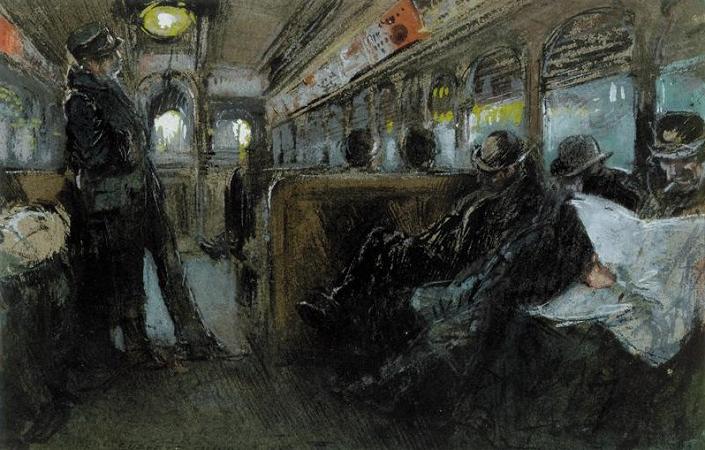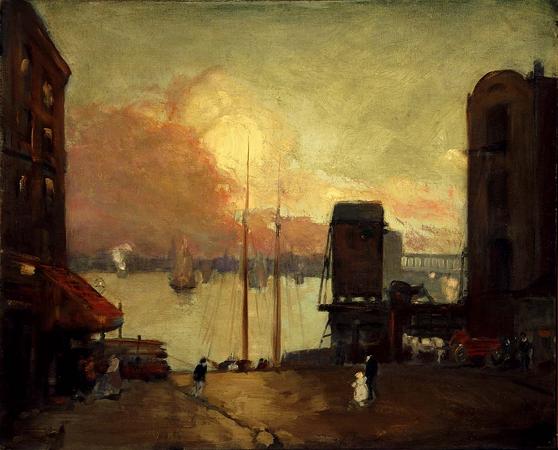Ashcan School Painting. The Ashcan School, also called the Ash Can School, was an artistic movement in the United States during the late 19th-early 20th century that is best known for works portraying scenes of daily life in New York, often in the city's poorer neighborhoods. The best known artists working in this style included Robert Henri, George Luks, William Glackens, John Sloan, and Everett Shinn. Some of them met studying together under the renowned realist Thomas Anshutz at the Pennsylvania Academy of the Fine Arts, others met in the newspaper offices of Philadelphia where they worked as illustrators. Theresa Bernstein, who studied at the Philadelphia School of Design for Women, was also a part of the Ashcan School. She was friends with many of its better-known members, including Sloan with whom she co-founded the Society of Independent Artists. The movement, which took some inspiration from Walt Whitman's epic poem Leaves of Grass, has been seen as emblematic of the spirit of political rebellion of the period. The Ashcan School was not an organized movement. The artists who worked in this style did not issue manifestos or even see themselves as a unified group with identical intentions or career goals. Some were politically minded, and others were apolitical. Their unity consisted of a desire to tell certain truths about the city and modern life they felt had been ignored by the suffocating influence of the Genteel Tradition in the visual arts. Robert Henri, in some ways the spiritual father of this school, wanted art to be akin to journalism. he wanted paint to be as real as mud, as the clods of horse-shit and snow, that froze on Broadway in the winter. He urged his younger friends and students to paint in the robust, unfettered, ungenteel spirit of his favorite poet, Walt Whitman, and to be unafraid of offending contemporary taste. He believed that working-class and middle-class urban settings would provide better material for modern painters than drawing rooms and salons. Having been to Paris and admired the works of Edouard Manet, Henri also urged his students to paint the everyday world in America just as it had been done in France. The name Ashcan school is a tongue-in-cheek reference to other schools of art. Its origin is in a complaint found in a publication called The Masses alleging that there were too many pictures of ashcans and girls hitching up their skirts on Horatio Street. That particular reference was published in The Masses at a point at which the artists had already been working together for about 8 years. They were amused by the reference and the name stuck. The Ashcan School of artists had also been known as The Apostles of Ugliness. The term Ashcan School was originally applied in derision. The school is not so much known for innovations in technique but more for its subject matter. Common subjects were prostitutes and street urchins. The work of the Ashcan painters links them to such documentary photographers as Jacob Riis and Lewis W. Hine. Several Ashcan School painters derived from the area of print publication at a time before photography replaced hand-drawn illustrations in newspapers. They were involved in journalistic pictorial reportage before concentrating their energies on painting. George Luks once proclaimed I can paint with a shoestring dipped in pitch and lard. In the mid-1890s Robert Henri returned to Philadelphia from Paris very unimpressed by the work of the late Impressionists and with a determination to create a type of art that engaged with life. He attempted to imbue several other artists with this passion. The school has even been referred to as the revolutionary black gang, a reference to the artists' dark palette. The group was subject to attacks in the press and one of their earliest exhibitions, in 1908 at New York's Macbeth Gallery, was a success. Many of the most famous Ashcan works were painted in the first decade of the century at the same time in which the realist fiction of Stephen Crane, Theodore Dreiser, and Frank Norris was finding its audience and the muckraking journalists were calling attention to slum conditions. The first known use of the term ash can art is credited to artist Art Young in 1916. The term by that time was applied to a large number of painters beyond the original Philadelphia Five, including George Bellows, Glenn O. Coleman, Jerome Myers, Gifford Beal, Eugene Higgins, Carl Springchorn and Edward Hopper. Photographers like Jacob Riis and Lewis Hine were also discussed as Ashcan artists. Like many art-historical terms, Ashcan art has sometimes been applied to so many different artists that its meaning has become diluted.
more...














